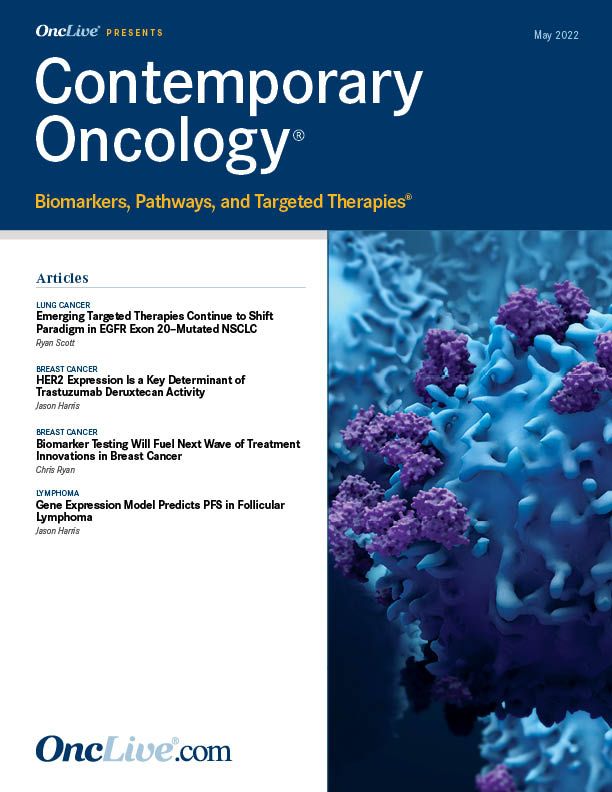Publication
Article
Contemporary Oncology®
Biomarker Testing Will Fuel Next Wave of Treatment Innovations in Breast Cancer
Author(s):
Christos Vaklavas, MD, discusses the increasing emphasis on investigating tumor biology in breast cancer, plus the evolving treatment landscapes in HER2-positive breast cancer, hormone receptor–positive, HER2-negative breast cancer, and triple-negative breast cancer.
Christos Vaklavas, MD

Significant progress has shifted the treatment paradigm in various spaces within breast cancer, including therapy options for patients with HER2-positive metastatic breast cancer, hormone receptor (HR)–positive, HER2-negative breast cancer, and triple-negative breast cancer (TNBC). However, further advancements in treatment will derive from increased knowledge surrounding biomarkers in breast cancer, according to Christos Vaklavas, MD.
“We are increasingly recognizing that we have to understand the biology [of breast cancer] better. Our approaches have to be tailored to the biology of the cancer. Right now, we are using crude biomarkers, like PD-L1, or even before that, [estrogen receptor (ER) and] HER2,” Vaklavas said in an interview with OncLive® following an Institutional Perspectives in Cancer (IPC) webinar on breast cancer, which he chaired.
In the interview, Vaklavas discussed highlights from the meeting, including an increased emphasis on investigating tumor biology in breast cancer, plus the evolving treatment landscapes in HER2-positive breast cancer, HR-positive, HER2-negative breast cancer, and TNBC. He is the physician leader in breast cancer at the Huntsman Cancer Institute and an associate professor in internal medicine in the Division of Oncology at the University of Utah.
OncLive®: Your presentation focused on HR-positive, HER2-negative breast cancer. What are the pertinent updates in this space?
Vaklavas: The addition of CDK4/6 inhibitors to a backbone of endocrine therapy, whether it is letrozole, anastrozole, or potentially exemestane, has been associated with equal magnitude of benefit in progression-free survival. We have started seeing benefit in overall survival [OS], specifically with ribociclib [Kisqali]. We do not know what the pharmacologic underpinning of this benefit is specifically with ribociclib. Whether this is practice changing, or whether we should start prescribing ribociclib, we do not know yet. [These developments] are giving us confidence that the CDK4/6 inhibitors are associated with benefits in OS, although perhaps not all to the same extent.
The second takeaway [involves] oral selective ER degraders [SERDs], a new class of drugs coming around. The phase 3 EMERALD trial [NCT03778931] was positive with elacestrant, but we found that a second study, the phase 2 AMEERA-3 trial [NCT04059484] with amcenestrant was negative. This new generation of SERDs may be effective in patients who have ESR1 mutations, whether they arise [at diagnosis] or they arise as a consequence [of treatment], and [the latter] is considerably more frequent. Those mutations [tend] to arise because of therapeutic pressure with first-line therapy.
The third point [relates] to what is coming [down the pipeline]: a series of agents for patients [who] progress on 1, 2 or, even 3 lines of endocrine therapy. There are novel antibody-drug conjugates [that are being studied in] HER2-positive and HER2-low breast cancer. In the next few months with the announcements of those results, [treatment options] will settle.
Mei Wei, MD, of the University of Utah, spoke about early-stage and metastatic HER2-positive breast cancer. What are some of the updates we have seen there?
[New] HER2[-targeted agents] are moving [into the] second-line [setting]. Recently in the New England Journal of Medicine, we saw [updated data the phase 3 DESTINY-Breast03 trial [NCT03529110] with fam-trastuzumab deruxtecan-nxki [Enhertu] vs ado-trastuzumab emtansine [Kadcyla; T-DM1] in patients with HER2-positive breast cancer. [Trastuzumab deruxtecan] has been incorporated in the National Comprehensive Cancer Network guidelines, and, [potentially] soon, the FDA is going to approve trastuzumab deruxtecan as a second-line therapy in the metastatic setting.
Treatment in the third line and thereafter are still in flux right now. We know that tucatinib [Tukysa] probably has a leading edge in [patients] with brain metastases, but there is some emerging evidence that [trastuzumab deruxtecan] may be efficacious in patients with active brain metastases, as well. It has not been specifically looked at, but there are studies that are looking into it right now. [This could be] practice changing.
Right now, a taxane, trastuzumab [Herceptin], and pertuzumab [Perjeta] is the preferred first-line therapy in the metastatic setting. [There have been] no changes in the adjuvant or neoadjuvant setting yet. In the first-line metastatic setting, a taxane, pertuzumab, and trastuzumab have been associated with benefits in OS. However, a lot of studies are ongoing in [the first-line] space to challenge the dogma of a taxane, trastuzumab, and pertuzumab.
In DESTINY-Breast03, the rate of interstitial lung disease (ILD) was lower than it was in the phase 2 DESTINY-Breast01 trial (NCT03248492). What are some of the interventional and management strategies that led to that reduction?
Early recognition [was key]. An algorithm for the management [of ILD] and the aggressive discontinuation of [trastuzumab deruxtecan] with grade 2 or greater ILD brought the rate down to around 10%, which is not significantly different from [the rate in DESTINY-Breast01 of] about 13%. There is still a lot to be learned about ILD and [our management] algorithm. There is still a lot to learn about the natural history. [Does increased exposure to the drug] increase the risk of ILD? Is there something idiosyncratic, something special with those patients that they are developing ILD?
We need to understand it, and I do have patients that have ILD or lymphocytic carcinomatosis of the lung. At least up until recently, we were appalled at the idea of giving those patients HER2[-targeted therapy]. Now, I am a little bit bolder and give those patients HER2[-targeted therapy] with the idea that the disease will go into remission, and [we can] worry about ILD later.
Namita Chittoria, MBBS, of the University of Utah, focused on TNBC. What is important for practicing oncologists to know about advancements in this space?
The biggest advance in recent years is the approval of sacituzumab govitecan-hziy [Trodelvy] as a third-line therapy [for patients with unresectable locally advanced or metastatic TNBC who received 2 or more prior systemic therapies, with at least 1 of prior therapy for metastatic disease]. The data are compelling to use this drug in patients with metastatic breast cancer.
The second biggest advance or practice-changing development was the approval of pembrolizumab [Keytruda] in the adjuvant setting alongside carboplatin plus paclitaxel, followed by epirubicin and cyclophosphamide in patients with stage II or III, early-stage, nonmetastatic, TNBC. There are some developments in terms of the adjuvant setting, such as the phase 3 OlympiA trial [NCT02032823], which evaluated [adjuvant] olaparib [Lynparza] in patients with a germline BRCA1/2 mutation.
Moving to the presentation by Cristina DeCesaris, MD, of the University of Utah, on novel and de-escalation radiotherapeutic regimens in breast cancer, what would you say has emerged in this space?
The techniques are getting better, and they are getting safer. The biggest advance is that there are many clinical trials whose results are going to be practice-changing, because they’re incorporating biologic features of the disease captured with [the Oncotype DX test], primarily to escalate or de-escalate radiation therapy. [The field is] moving away from the one-size-fits-all [treatment approach] and is looking into the biology of the disease and accordingly tailoring [a patient's] radiotherapeutic approach.
Do you have any anecdotal experiences with de-escalated therapy?
Our institution participates in the phase 2 I-SPY trial [NCT01042379]. Up until recently, the dogma was to complete a set of agents in the preoperative setting. I-SPY has pushed the envelope a little further, and with the use of MRI and biopsies, we get what is called a pre–residual cancer burden [RCB]. Pre-RCB [gives] the probability of having achieved complete pathologic response [pCR] based on the MRI and the tumor biopsy.
If the pre-RCB is high, the patient has a high likelihood of having achieved a pCR. Then they do not need to receive epirubicin and cyclophosphamide, the second half of the treatment. Thus far, with all the patients that we have subjected to pre-RCB, their pre-RCB [result] was consistent with [their achieving] a complete response. [In those cases,] we omitted the epirubicin and cyclophosphamide, and the patients underwent surgery.
Is there any ongoing or planned research at Huntsman Cancer Institute that you wanted to highlight?
The FORESEE trial [NCT04450706] that we are doing integrates the development of patient-derived xenografts and patient-derived organoids in patients with HR-negative breast cancer. [The study is examining] newly diagnosed patients with metastatic breast cancer––either TNBC [in the] first line or HR-positive, HER2-negative breast cancer that has exhausted endocrine options. We take a biopsy, and we generate patient-derived organoids. Those organoids are miniature reflections of the patient’s cancer, and we leverage those organoids to conduct medium-throughput drug screens.
We integrate the information we collect from those medium-throughput drug screens, [along] with circulating tumor DNA and tumor tissue DNA testing and compile a report that we share with the patient, with the most likely drugs that the patient will respond [to] as a second-line therapy.
We would like to foresee what the optimal treatment is for patients in the second line in metastatic TNBC or metastatic HR-positive, HER2-negative breast cancer that has exhausted all endocrine options, because right now, the choice of second-line therapy comes down to a little bit of guessing work. We [usually] give patients chemotherapy that the cancer has not seen before, assuming that these chemotherapies will have the best benefit. However, we call it functional precision oncology, because essentially, we move it one step further. We don’t look at the DNA and the RNA right now. We take snapshots of the genomic composition of the cancer. But we leverage those organoids to do medium-throughput drug screens.
What other questions are trying to be answered in clinical research in breast cancer?
Some of the questions have to do with what the future will bring and how all those novel therapies are going to be integrated. The phase 3 KEYNOTE-355 trial [NCT02819518] led to the current standard of care of chemotherapy with pembrolizumab. The key question that I have is whether we need to treat everybody with this intensive regimen vs spreading a few agents, spreading a few cycles, or spreading certain toxicities [over time] in patients who are going to do well either way. We as a scientific community are doing clinical trials to understand [that and] de-escalate therapy. We are not there yet, but hopefully we are going to get there.
How would you summarize all the advances that we have seen in breast cancer recently, where the field is now, and potentially where it is heading?
Now we are [relying more on] MammaPrint, OncotypeDX, next-generation sequencing, PIK3CA [mutation status], mutational burden, and mismatch repair proficiency or deficiency. All those biomarkers are increasingly having therapeutic implications. Advances in understanding the biology of breast cancer bring more biomarkers and more biomarker-driven therapeutic interventions [to patients].









